Some men are born to greatness. George Smith Patton actively cultivated it. A man of truly breathtaking ambition, Patton’s stated lifelong quest for the Medal of Honor was destined for frustration.
A marginal student but a rapacious reader, Patton enjoyed an almost pathological drive to succeed. In the final analysis, George Patton became arguably the most effective fighting general in American military history. His combat career, however, was nearly cut short during a vicious engagement with Mexican bandits as part of the 1916 Punitive Expedition to defeat Pancho Villa.
The Setting
In March of 1916 a mob of paramilitary cutthroats under the command of Jose Doroteo Arango Arambula, more commonly known as Francisco “Pancho” Villa, attacked and burned the small town of Columbus, New Mexico.
In the process, Villa killed eight American Cavalrymen stationed there along with another eight to ten civilians. He made off with three hundred captured rifles and shotguns but lost a quarter of his force in the process. He also incurred the fulminant wrath of both President Woodrow Wilson and the American people.
Five months later there were 100,000 American troops poised on the border.
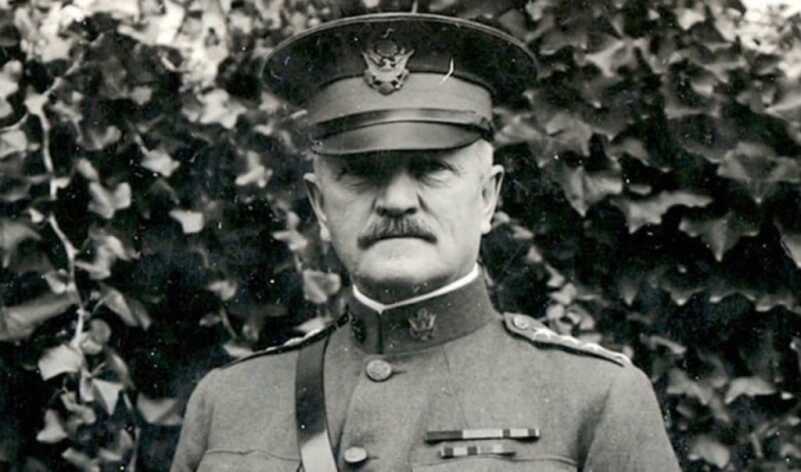
General John J. “Blackjack” Pershing commanded both the Punitive Expedition into Mexico as well as American forces in Europe during World War 1.
The Punitive Expedition was led by John “Blackjack” Pershing and was tasked with capturing Villa.
This military operation was the first in US history to employ motorized ground transport as well as airplanes in a reconnaissance role.
A Hero’s Beginnings
By 1916 Second Lieutenant George Patton had already etched a deep mark. He attended the Virginia Military Institute for a year before entering the US Military Academy in New York. His academic failure in mathematics necessitated his repeating a year at West Point.
An avid swordsman, Patton studied experts in the US and Europe and designed the M1913 Cavalry Saber that became known as the “Patton Sword.”
He was granted the title “Master of the Sword” for his efforts. I’m not sure exactly what that means, but it sounds awesome.
Lieutenant Patton represented the United States in the pentathlon at the 1912 Olympics in Stockholm, Sweden. While the other Olympians ran .22-caliber pistols for the shooting component of the event, Patton elected to wield a .38-caliber Colt target revolver.
The young officer was docked a shot as having missed the target altogether with his final round. Patton claimed that the bullet passed through the ragged hole left by the preceding shots. As he had fired a perfect score the previous day this is not an unreasonable claim.
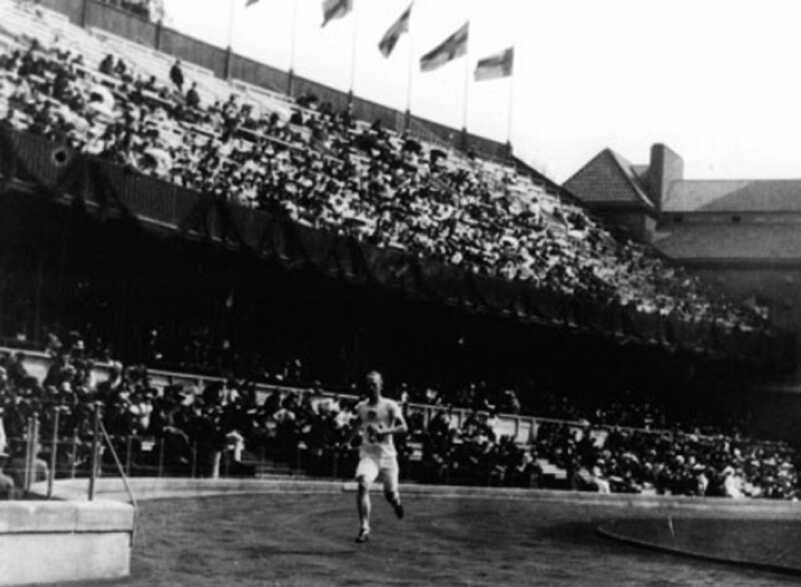
One man actually died during the 2.5-mile cross-country run that defined the 1912 Olympic pentathlon. This is George Patton during the run.
When the pentathlon was complete, several competitors had fallen away and one actually died. Patton came in fifth overall. Had he gotten credit for shooting up to his typical standard he would have taken the gold.
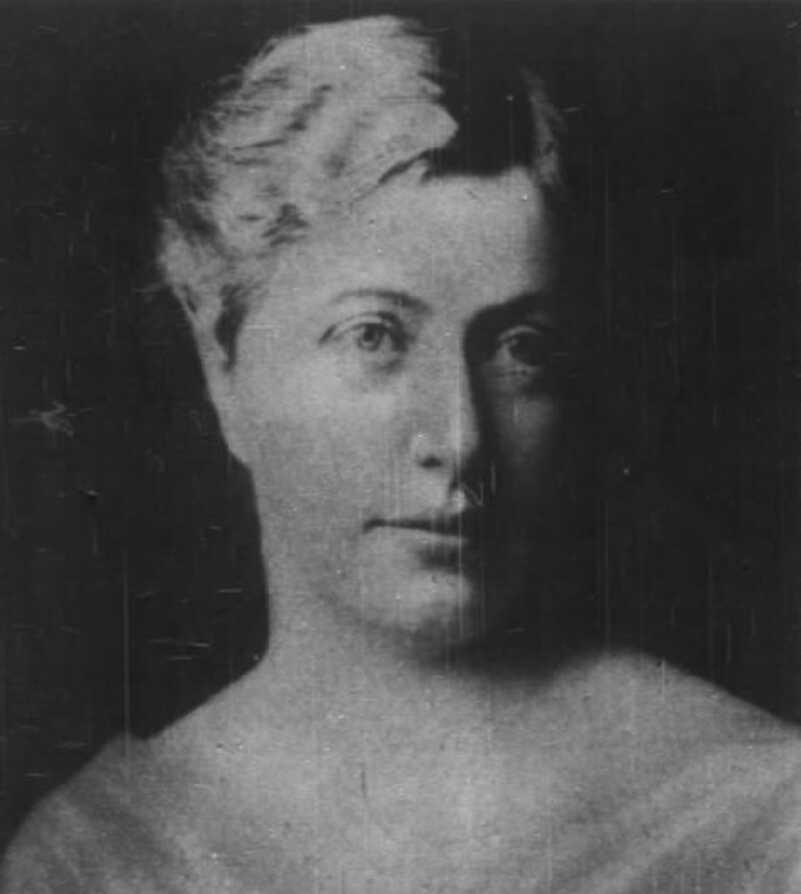
General Pershing was engaged to George Patton’s younger sister Nita. They eventually broke off the engagement.
Concerned that he might miss the pending military action in Mexico, Patton appealed directly to Pershing. Blackjack agreed and made Patton his personal aide. The fact that Pershing was engaged to Patton’s younger sister Nita likely did not harm his prospects.
The Mission
Eager to command troops in combat, 2LT Patton requested and received a billet to Troop C of the 13th Cavalry hunting Pancho Villa. Julio Cardenas was a Captain in Villa’s band of rogues and his overall 2IC. Cardenas also commanded Villa’s personal bodyguard.
While out scavenging for corn for the unit’s horses, a small party of ten American cavalrymen along with a pair of civilian guides under Patton’s command came to a ranch near the town of Rubio, Mexico. Realizing that Cardenas had family at the ranch, Patton undertook a detailed recon of the area from a variety of vantages. Lieutenant Patton subsequently identified Cardenas and a pair of his henchmen at the facility.
On May 14, 1916, Patton led his small attack force in three Dodge touring cars cross country in the first motorized assault in US Army history. At around noon, Patton staged two of his vehicles as a blocking force, dismounted, and approached the compound by stealth along with two members of his party. He carried a rifle in his left hand and his ivory-handled engraved Colt Single Action Army revolver in his right.

Patton had a bad experience with John Browning’s classic military automatic that drove him to wheelguns.
Some weeks before, Patton was at a local watering hole enjoying the nightlife with his issue Colt 1911 automatic pistol shoved into his belt. The weapon discharged unexpectedly and soured the young officer to a degree.

Patton’s customized Single Action Army became part of his mythos. The original is on the top. The gun used in the 1970 biographical movie is shown on the bottom.
As a result, he privately purchased his famous Colt SAA revolver for $50 and had it customized with ivory grips and extensive engraving. Patton loaded his wheelgun with five rounds, leaving the chamber underneath the hammer empty. This was the state of the weapon he carried as he approached the San Miguelito Ranch.
Patton’s First Gunfight
Patton and his subordinates made their way around the low wall that surrounded the ranch and was eventually spotted by the three bandits. Just as planned, the mounted Mexicans fled the small team only to run into Patton’s well-sited blocking force.
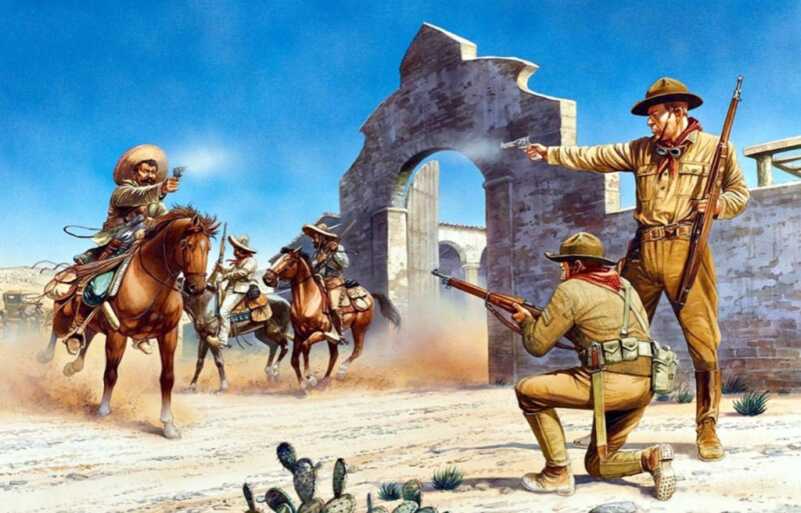
The shootout between 2LT George Patton and the Mexican bandit Julio Cardenas showed the young American officer to be calm and professional under fire.
Wheeling their mounts around, the three charged back at Lieutenant Patton and his soldiers, their guns blazing. George Patton leveled his Colt and emptied all five rounds.
One round struck Cardenas in the arm, shattering it. Another felled his horse. Having recharged his sixgun Patton shot the horse of one of Cardenas’ companions as it galloped by, dropping the animal and spilling its rider. Once the bandit disentangled himself from the wounded animal, Patton and his men gunned him down.
The story goes that this man was armed with a lever action rifle that jammed just as he was about to shoot. The young Lieutenant kept the gun and left it in its choked state, insisting that it never be cleared. The gun with its action locked open was on display at the Patton Museum at Fort Knox for decades. Given the remarkable reliability of lever action rifles, Patton saw this fortuitous failure as an example of divine providence.
The third bandit escaped the compound and galloped away as fast as his mount could run. Patton transitioned to his bolt-action Springfield rifle and, along with his men, blew the retreating Mexican out of his saddle. Meanwhile, the wounded Cardenas was attempting to escape on foot.
One of Patton’s guides, a turncoat Villa soldier named E.L. Holmdahl, pursued the wounded man into a nearby field. Cardenas feigned surrender only to draw his pistol, fire, and miss. For his trouble, Holmdahl put a bullet through the Mexican bandit’s brain.
The Rest of the Story

General Pershing had no interest in the three dead Mexicans but was mightily impressed with his aide George Patton.
Patton strapped the bodies of the three dead bandits to the hoods of his cars and returned to his encampment forthwith leaving around fifty pursuing Mexican bandits on horseback in his dust. The baking Mexican sun did not improve the state of the three dead men by the time he presented them as spoils of war to his commander, General Pershing. Blackjack wanted little to do with the demised and rapidly ripening Mexicans and had them buried on the spot.
Pershing was, however, quite impressed with the performance of the firebrand Patton, referring to him as “Bandit” informally from then on and promoting him to First Lieutenant nine days later. The engagement found its way into newspapers the world over and poured kerosene on the smoldering flame that was George Patton’s ego. All these things conspired to secure for Patton a billet alongside Pershing when he deployed to France the following year to join the hemoclysm that was World War 1.
Patton’s combat acumen as a tank commander in the First World War and his mastery of the art of maneuver warfare in the Second is well-documented.
Tactical Lessons
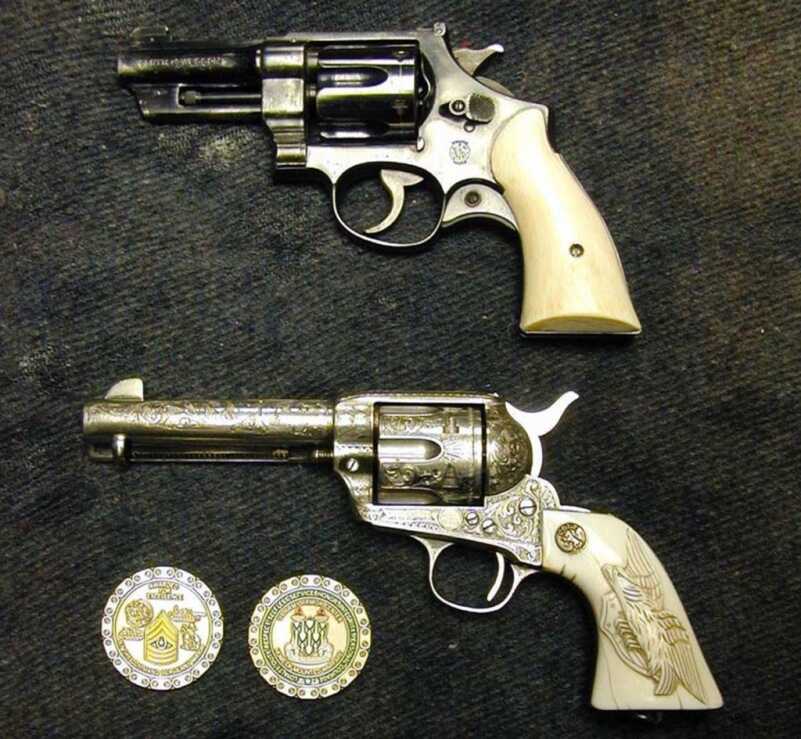
The pair of custom wheelguns Patton carried during World War 2 became some of the most recognizable firearms ever made.
George Patton carved a pair of notches in the grip of his Single Action Army to commemorate the two Mexican bandits he helped dispatch. While the inimitable reliability of the venerable Colt revolver clearly left a mark, Patton had not enjoyed having to laboriously reload his weapon under fire.

Patton’s frustration with the limited capacity of his SAA led him to pack a pair of six guns when in a combat zone.
For this reason, he typically carried a pair of wheelguns in combat later during World War 2.

Patton’s .357 Smith and Wesson Registered Magnum later became known as the Model 27. He bought the gun directly from S&W in 1935 for $60.
Patton packed a matched pair of Colts for a time but gifted one to a famous USO performer. He replaced the single action .45 with a Smith and Wesson .357 Registered Magnum sporting a 3.5-inch barrel.

Patton carried a variety of backup guns. He once fired at attacking German aircraft with a Remington R51 .380 like this one.
He was also known to carry a Remington R51 .380 as well as a snub-nosed revolver and the occasional M1903 Colt hammerless. During one particularly harrowing engagement, Patton stood in his staff car and fired at attacking Luftwaffe planes with his R51 pocket pistol. What a stud.
The M1A1 Thompson submachine gun that was his constant companion on trips to the front is on display at West Point today.
George Smith Patton broke the mold. A peculiar man of devout faith and spectacular profanity, it was his strange dichotomy combined with a straight-for-the-throat command philosophy that made him the most feared General Officer in the Allied stable. I had a friend who met him twice. He once told me that Patton was every bit the flamboyant character in person that the history books depict. While he likely would not have made it past Lieutenant in today’s woke Army, General George Patton was clearly the stuff of heroes.

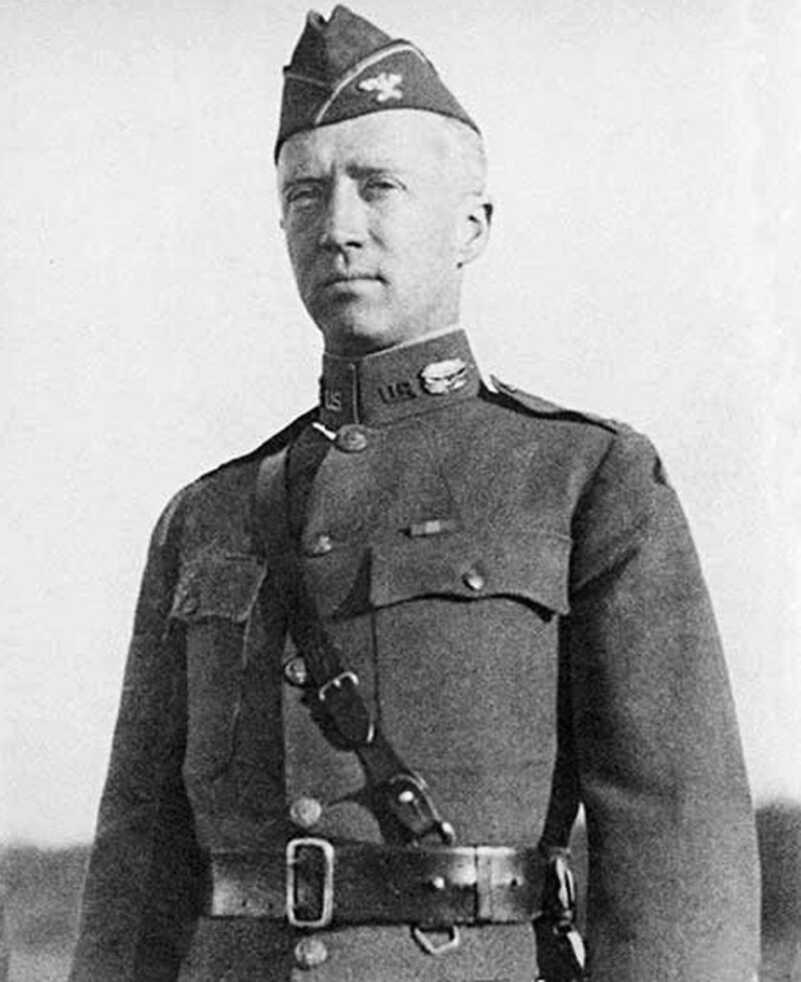

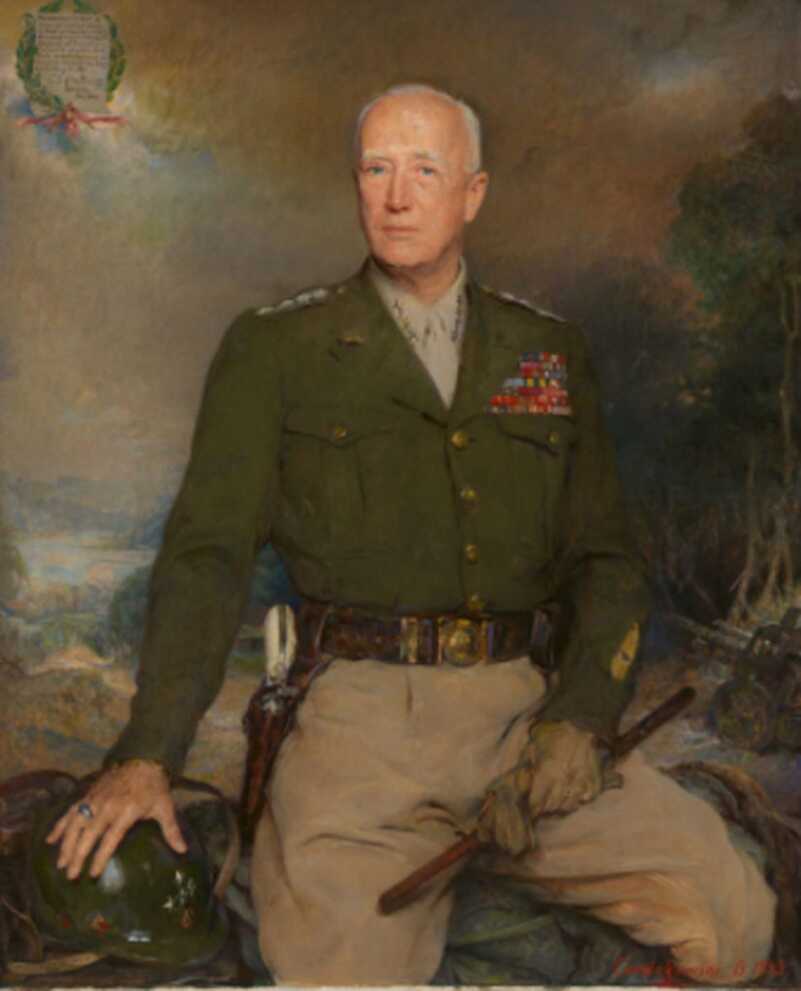
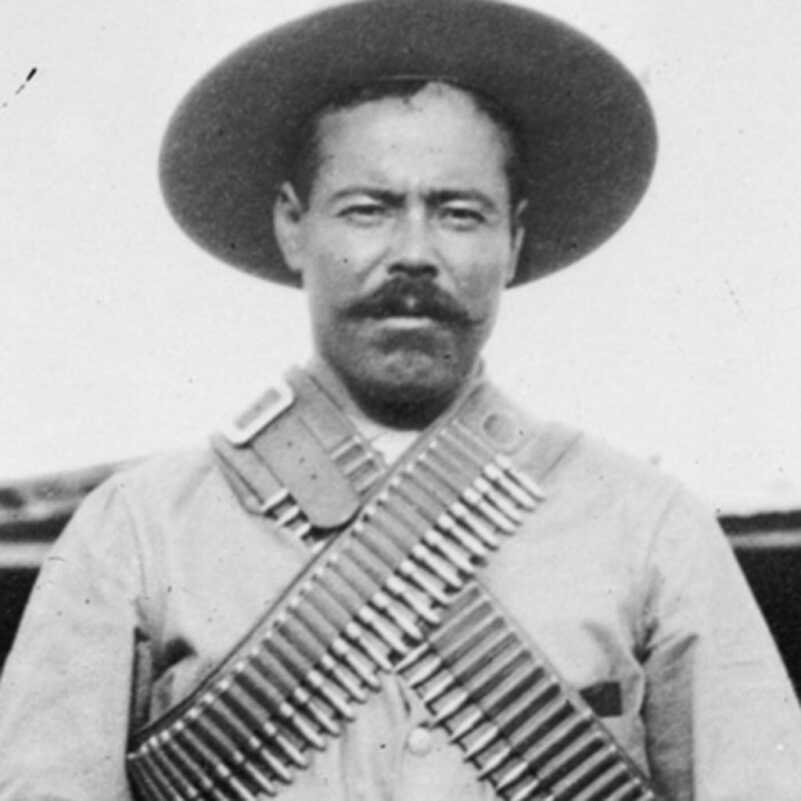
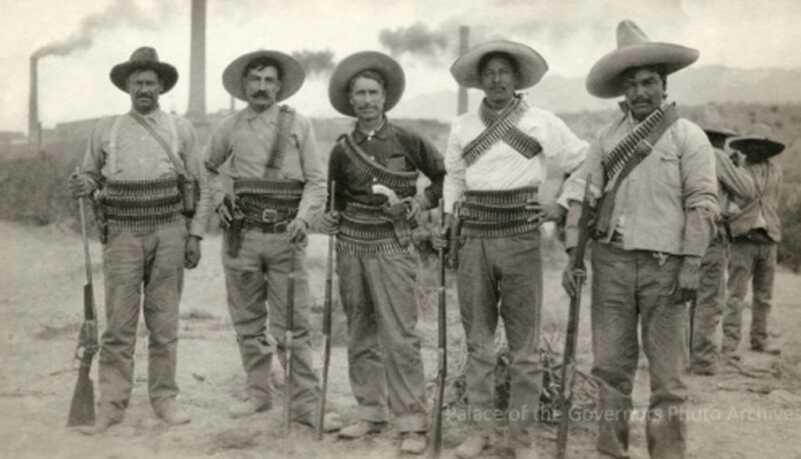



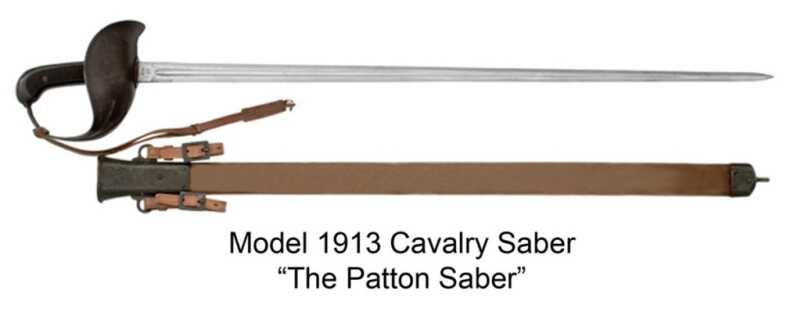

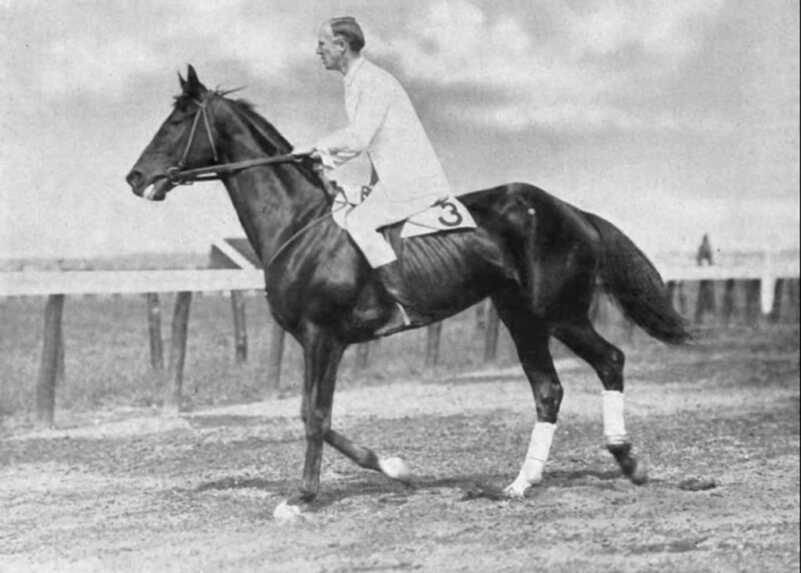

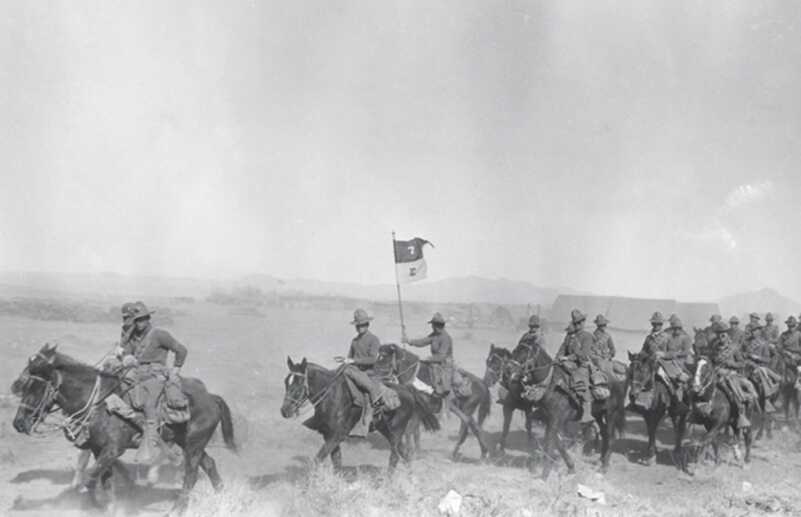

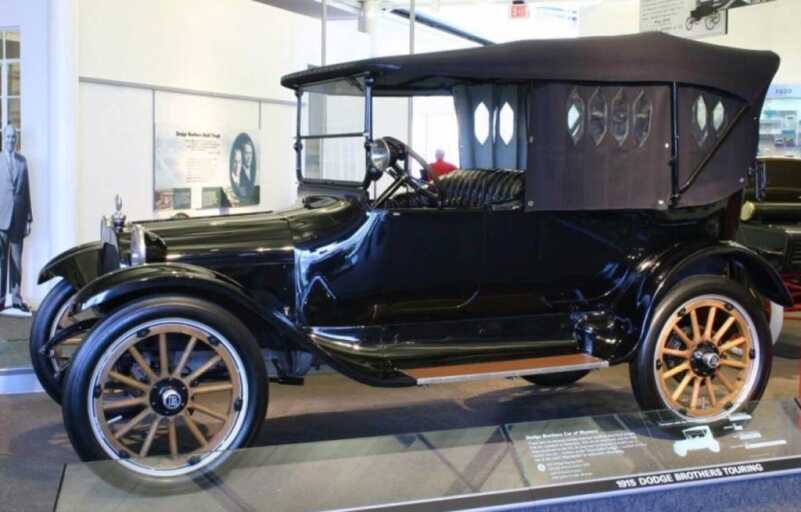

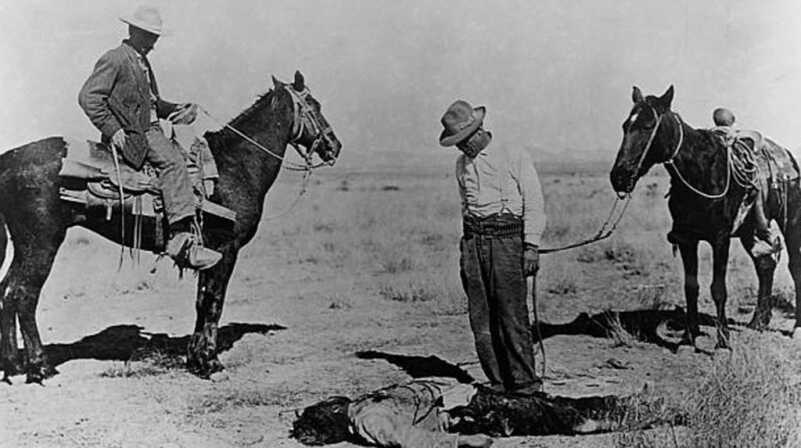
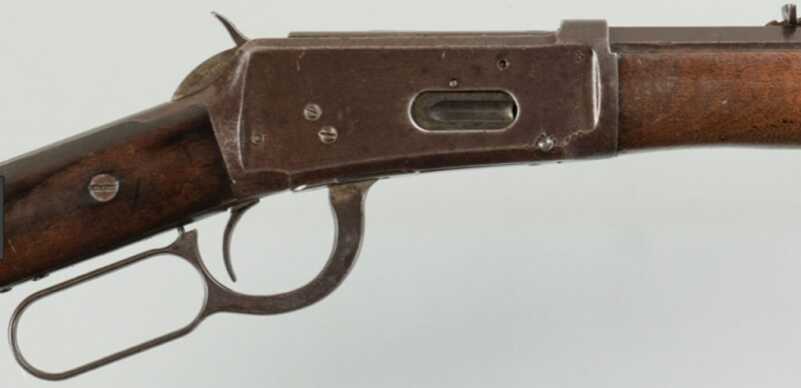



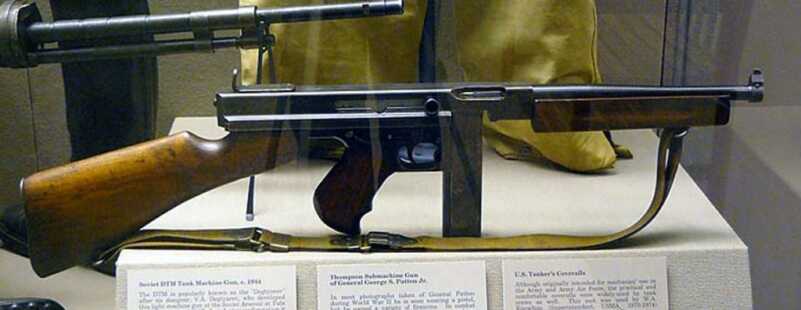



Patton’s grave is amongst many other servicemen killed in WWII and buried in the Luxembourg American Cemetery near the Lux City Airport. This American Cemetery will make you cry if you never been to one before. Amazingly, there’s a corresponding cemetery for the German soldiers across the road, and it is equally tranquil and impressive (in a sad way for all the dead). Patton had asked in his last wishes to be buried in Luxembourg with his fellow men, because he was a national hero of that country. He had helped liberate that country twice in two world wars, and the Luxembourg citizenry revered him.
Thanks once again for a fact filled and fascinating story. I live in the desert southwest and the recent history rings clear. Though I am from a Navy family and a retired USN officer, I have always enjoyed the history of George Patton, Mark Clark, Omar Bradley etc. I certainly agree with the comments regarding stopping the Communist forces in Germany and Korea. I do not understand the degree or emotion in which patriotism ends. I think folks on this site are not fanatical, but quite aware/concerned about the assaults/insults to being an American and how precious our freedoms are. Thanks again Doc.
Boy the things that history does not teach us! I think high schools and colleges should teach the true things of war,maybe we would grow up with better ideas to fight them,i have learned more after high school watching documentaries and doing my own research,i am of German decent,Germany had basicly a civil war in the 1800s and how my ancestors left Germany and came to Arkansa and bought land to build a church,my last name is Son,which was spelled Sohn in the beginning,there is a Sohn River somewhere where the Americans had to blow up the Sohn Bridge,it must be in Germany.I remember when Sadam’s troops surrendered and our soldier built a makeshift jail and fed the soldiers that surrendered starving people is never a good idea,even now there is going to be a wheat shortage becuase Putin is going to take all the wheat from farmers,which will give the people more resolve to fight,Abe Lincoln had 38 Native Americans hung because they were starving and fought the whites and killed them,so Ole honest Abe made an example of them.The europeans took land and shoved them back to the banks of the Mississippi river which gave them nothing to hunt and they were starving,didn’t learn that in school either.I have many books on Native Americans. I learned more here today than i have before, i don’t think any different about DDE,maybe he was a great leader,i was not alive then.i don’t like what they did to the Jewish,but i;ll be damned if i would do the same thing!
I wonder what Gen Patton would think of the tepid response Americans are displaying to this tyranny we are enduring from our own government? They sacrificed everything for us and we offer nothing in return to show our appreciation. Not even so much as a whimper….
Villa was hardly a murderous bandit. He was and continues to be a hero in Mexico. Raised as a peon basically a slave to rich landowners, he killed a ranch owners son that had raped his sister and fled to avoid being killed. As a teenager he joined a band that raided rich landowners stealing their cattle to survive. He later joined Francisco Madero elected to the Mexican presidency that promised to eliminate the slavery that was strangling the Mexican common people. Madero was murdered shortly after gaining the presidency and the rich once again with help from American business took over the country. Villa with nothing but his charisma and guts raised an Army of peasants and led them to victory over them. Offered the presidency, he declined it this so called bandit saying that he did not have the intelligence to serve in that capacity and he went back to become a common citizen. However, the landowners came back and this entire episode was repeated over several years. Villa invaded Columbus, NM because he felt betrayed, which he was by the American government which allowed the use of American railroads to flank his Army and also deprived him of arms and ammunition. Pershing’s force never captured him and after earning the wrath and several minor battles in Mexico, the force was recalled to the U.S. As far as Villa, in the end the Mexican government agreed to a truce with him and he was given a ranch and he kept a force of 50 Dorados as a personal guard for there were many that wanted to kill him. He was murdered years later. Hardly a bandit except this keeps being repeated among among Americans.
Interesting. If you have not yet, look into the San Patricios in the “Mexican-American War.” This was a group of US soldiers, mostly Irish but some German and all Catholic that went to the Mexican side because of the injustice of that war the mistreatment of Mexican people.
As a young officer US Grant even acknowledged the dubious motives of the war on Mexico. That war was probably the early stages of the globalists that would be followed later by the likes of the fake “Colonel” House who manipulated Woodrow Wilson targeted the neighbor to the south and today with Soros et cetera.
Marines are taught the customs, curtesy and history of the Corps from day 1 of boot camp. The story of Chapultepec is taught as a battle where Marines suffered the greatest loss of Officers and NCO’s in a battle which might have been the origin of the “blood stripe” along the legs of Officers and NCO’s. What is left out of the US history is that those brave young Mexican Cadets at the Castle knew that the captured San Patricio’s would be hanged when the Stars and Stripes was raised in Castle.
The US soldiers that deserted before the war and joined with their Catholic brothers in arms could not be hanged but a big “D” was branded on their faces. A gent named Riley or O’ Riley was the leader of the Saint Patrick brigade and he was branded twice for spite. There is also the theory that the derogative term gringos may originate from a totally innocent term describing the ST. Patrick brigade.
This is one of many chapters written out of the US history where there was contempt and mistreatment of Catholics. The St Patrick brigade was made up of many men who had been mistreated in their native homeland for their religious beliefs and chose to put God then Country in the priority many claim to cherish.
George Patton was often brutal towards German soldiers in battle but even he was disgusted with the treatment of the Germans by the “Supreme Commander,” DDE, during the closing stages of the war and beyond. Dwight David Eisenhower stripped the Germans of their Geneva Convention protections and created an illegitimate status of “Disarmed Enemy Forces” that resulted in French and American run death camps along the Rhine River. German soldiers and civilians had no shelter and a diet less than 1000 calories per day that surely led a death rate of 30% and around 1 million deaths.
Of course, plagiarists like the fool Steven Ambrose and the moron historians of the New Orleans panel dispute the groundbreaking research of James Bacque, fine. Here are some facts on Patton that cannot be denied. Patton admired the German race and despised the way his former friend, DDE, treated Germans. Patton knew the victories Allies were destroying the great German race and he said as much. Patton disregarded vengeful DDE’s death Camp directives. DDE’s illegal policies were also throwing innocent German civilians out of their homes and moving in what Patton considered the Communist scum of the earth from the “liberated” concentration camps.
DDE was a political soldier who was state side during WWI and should NOT have been the “Supreme Commander” and in fact should have been drummed out of the military for a pay fraud scheme he committed as a young officer, but he was connected with a Bernard Baruch, et cetera. DDE was of Jewish dissent, a fact he tried to hide, and which might explain his expressed hatred for Germans. DDE was also soft on Communism and was President during an era that the “Nuremberg Laws” were regularly violated. DDE is a good place to start when investigating the strange death of George Patton.
Oh how your last sentence is so telling. My claim to fame is being born in the same hospital where Patton passed.
Love reading your articles. You should publish them in a book. If so, I’m shipping you a copy for signature!
Daniel
Yet again , a great article Sir .
The General was an American icon . His distaste for communists was
legendary , some conspiracy theorists suggest it lead to his demise .
( May be an idea for a future installment )
His suggestion of arming our former German enemies , and allowing
them to assist in the attack upon the soviets , in my opinion , was sound
and may have saved Americans several future headaches .
But we all know the old saying about opinions , don’t we ?
I firmly believe that the Remington 51 was the correct name NOT R51 which was a very late version
regards
Great read, thanks. I was stationed in Heidelberg some years back and Patton history was everywhere.
1. I recall the x-ray room that was room where he died. There was a plaque on the wall outside.
2. One of Kasernes there was named Patton Barracks.
3. I have sat at the desk that Patton took from Rommel’s Normandy HQ which was located at Grafenwoehr. Signed the book and got the photo.
4. Lastly, I’ve been to intersection in Mannheim where he had his “accident”. If you believe his death was and accident.
Good morning, Will. If memory serves me correctly, one of your elder in-laws was a rifleman under Patton. If it’s the gentleman I spoke with some years ago in Bolivar County, he was with “Old Blood & Guts” from Sicily through the end of the war.
If you haven’t written about him already, Patton’s Grandfather (the first George S. Patton) was also quite the officer in his own right, and would be a great subject for one of your articles. In the case of these two “George S. Pattons”, there were some task-oriented, soldierly genes passed on to a successive generation that desperately needed them.
Our powers to be at the time of WW2 should have turned him loose on the Russians like he wanted them too!!!! We wouldn’t be having this troublesome world we have right now.
The same goes for MacArthur when he wanted to kick China’s ass During the Korean war. That would have eliminated both North Korea & China from being trouble makers.
We had our forces in place both times with the ability to end this world madness we currently have!!!!!!!!!!!!!!!!!!!
Weak politicians in this country are responsible for the condition the world is in right now!!!!!!!!!!!!!!!!!!
Yes, ALL of our weak politicians are woke liberal socialist communist a§§ kissing democrats!
Great article, They broke the mold when they made General Patton. Your last sentence in the article is definitely the most accurate statement, even though we have true warriors within our armed forces the leadership is probably the worst I have ever seen. I rather have a lion lead a pack of sheep than have a sheep lead a pack of lions.
Ah, Will…
I never cared much about military history, but YOU make it interesting. The famous names (Patton, Pershing, etc.) now have salient facts attached to them in my memory.
You also help show the world that doctors can be shooters, too.
You make me want to put down the MRI report (I am a radiologist, remember) and pick up a pen!
Never stop, Will.
Paul Shaderowfsky, MD